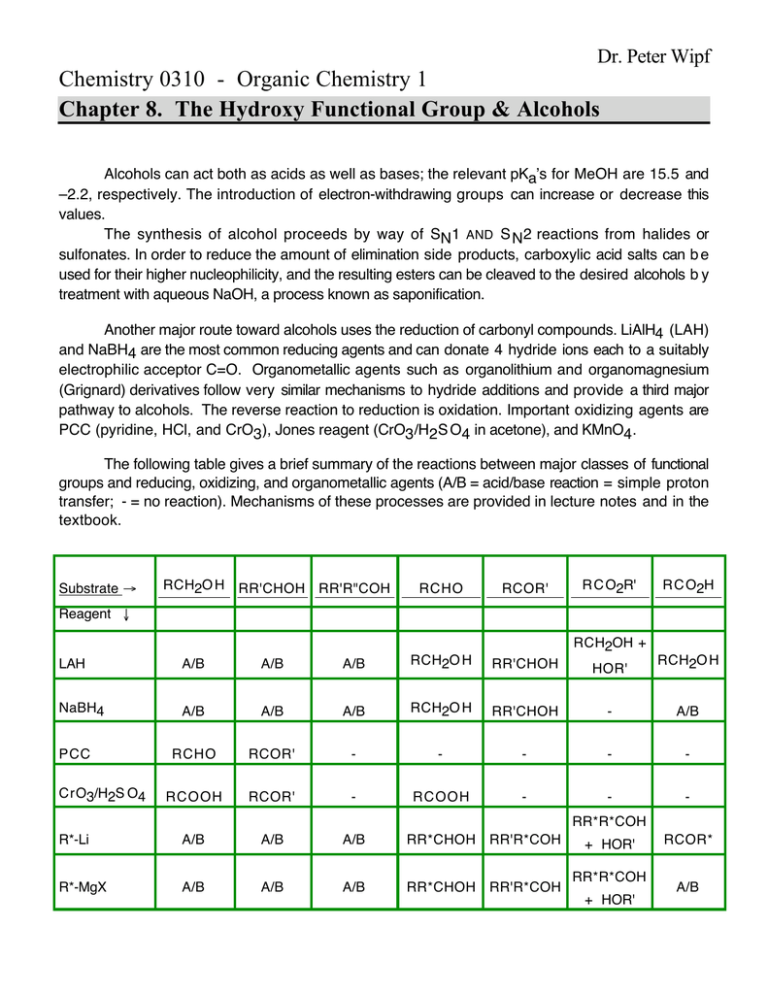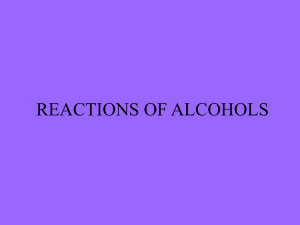Chemistry 0310 - Organic Chemistry 1 Dr. Peter Wipf
advertisement

Dr. Peter Wipf Chemistry 0310 - Organic Chemistry 1 Chapter 8. The Hydroxy Functional Group & Alcohols Alcohols can act both as acids as well as bases; the relevant pKa’s for MeOH are 15.5 and –2.2, respectively. The introduction of electron-withdrawing groups can increase or decrease this values. The synthesis of alcohol proceeds by way of SN1 AND S N2 reactions from halides or sulfonates. In order to reduce the amount of elimination side products, carboxylic acid salts can b e used for their higher nucleophilicity, and the resulting esters can be cleaved to the desired alcohols b y treatment with aqueous NaOH, a process known as saponification. Another major route toward alcohols uses the reduction of carbonyl compounds. LiAlH4 (LAH) and NaBH4 are the most common reducing agents and can donate 4 hydride ions each to a suitably electrophilic acceptor C=O. Organometallic agents such as organolithium and organomagnesium (Grignard) derivatives follow very similar mechanisms to hydride additions and provide a third major pathway to alcohols. The reverse reaction to reduction is oxidation. Important oxidizing agents are PCC (pyridine, HCl, and CrO3), Jones reagent (CrO3/H2S O4 in acetone), and KMnO4. The following table gives a brief summary of the reactions between major classes of functional groups and reducing, oxidizing, and organometallic agents (A/B = acid/base reaction = simple proton transfer; - = no reaction). Mechanisms of these processes are provided in lecture notes and in the textbook. Substrate Æ RCH2O H RR'CHOH RR'R"COH RCHO RCOR' R C O2R' R C O2H Reagent Ø RCH2OH + LAH A/B A/B A/B RCH2O H NaBH4 A/B A/B A/B RCH2O H RR'CHOH - A/B RCHO RCOR' - - - - - RCOOH RCOR' - RCOOH - - - PCC CrO3/H2S O4 RR'CHOH HOR' RCH2O H RR*R*COH R*-Li A/B A/B A/B RR*CHOH RR'R*COH R*-MgX A/B A/B A/B RR*CHOH RR'R*COH + HOR' RR*R*COH + HOR' RCOR* A/B Organometallic reagents can be prepared from the corresponding organohalides and Li or M g metal. Another important pathway is proton transfer to generate an organometallic compound of decreased basicity from a derivative of higher basicity. The differential reactivity of different reducing, oxidizing, and organometallic agents allows the selective bond formation and structure manipulation, a strategy that is employed in the process of retrosynthetic analysis. Retrosynthesis is the process of “deconstructing” a target molecule into readily available starting materials by means of • imaginary breaking of bonds (disconnections) and by the • conversion of one functional group into another (functional group interconversions). OH Target Molecule Ph Ph pathway B pathway A OH OH Synthons Ph Ph Reagents ? Br Ph Ph O Ph BrMg Ph Synthons Reagents Ph








